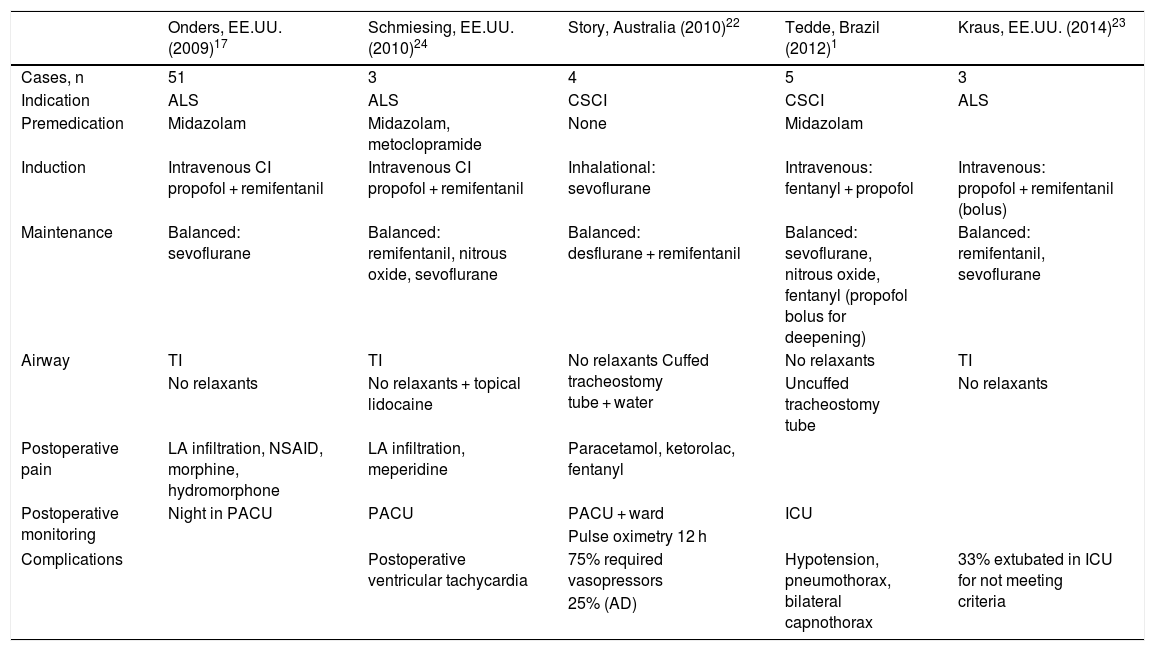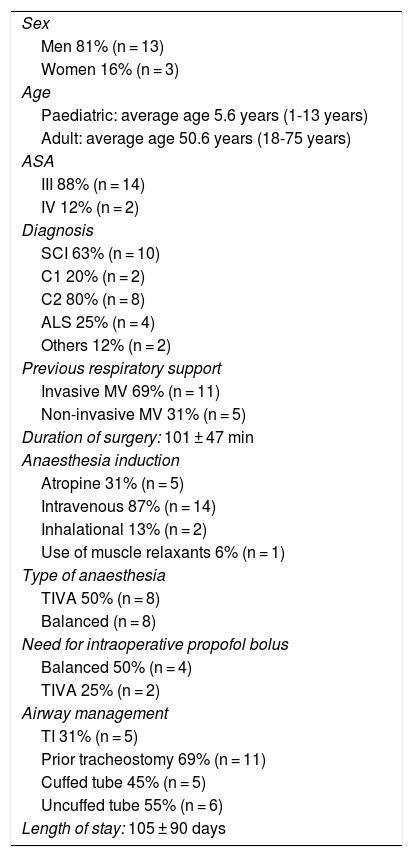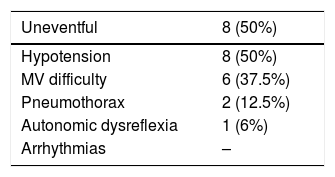The diaphragm pacemaker (DP) has proven its utility in replacing mechanical ventilation in patients with chronic spinal cord injury (SCI) and amyotrophic lateral sclerosis (ALS). The DP improves patient quality of life and reduces morbidity and mortality and their associated health care costs. The anesthetic management of these patients and the particularities of the surgical procedure are challenging. The aim of our study is to analyze anaesthetic management and intraoperative complications in patients undergoing DP placement in our hospital.
MethodsWe performed a chart review of patients treated between December 2007 and July 2017, recording the patients' preoperative status, anesthetic management and intraoperative complications.
ResultsThe study included 16 patients (5 pediatric) undergoing DP implantation for chronic SCI (63%), ALS (25%) and other neurologic conditions (12%). Abdominal laparoscopy was performed under general anesthesia, with intravenous (87%) or inhalational (13%) induction and maintenance using total intravenous (50%) or balanced (50%) anesthesia. Rocuronium was administered in one case to permit airway management. Complications included: hypotension (50%), difficulties in mechanical ventilation during laparoscopy (31%), pneumothorax (12.5%) and autonomic dysreflexia (6%).
ConclusionsDP placement under general anaesthesia is a safe intervention in both adult and paediatric patients. Complications derived from both the underlying disease and the surgical technique may appear, and must be rapidly identified and treated to obtain a satisfactory surgical outcome.
El marcapasos diafragmático (MD) ha demostrado su utilidad en la sustitución de la ventilación mecánica en pacientes afectos de lesiones medulares crónicas (LMC) y esclerosis lateral amiotrófica (ELA), mejorando la calidad de vida y reduciendo la morbimortalidad y los costes sanitarios asociados. El manejo anestésico de dichos pacientes y las particularidades del procedimiento quirúrgico suponen un reto anestésico. El objetivo de nuestro estudio es el análisis del manejo y las complicaciones intraoperatorias de los pacientes sometidos a MD en nuestra institución.
MetodologíaSe trata de una revisión retrospectiva entre diciembre de 2007 y julio de 2018. Se recogieron datos sobre el estado previo del paciente, el manejo anestésico y las complicaciones intraoperatorias.
ResultadosSe incluyen 16 pacientes (5 pediátricos) con indicación de MD por LMC (63%), ELA (25%) y otras enfermedades neurológicas (12%). Se requirió anestesia general para la laparoscopia abdominal utilizando inducción intravenosa (87%) o inhalatoria (13%) y anestesia total intravenosa (50%) o balanceada (50%) para el mantenimiento anestésico. En un caso se administró rocuronio para un óptimo manejo de la vía aérea. Las complicaciones registradas incluyeron: hipotensión arterial (50%), dificultades en la ventilación mecánica durante la laparoscopia (31%), pneumotárax (12,5%) y disreflexia autonómica (6%).
ConclusionesLa colocación de MD bajo anestesia general es una intervención segura, tanto en el paciente adulto como en el pediátrico, en la que pueden aparecer complicaciones derivadas tanto de la enfermedad de base como de la técnica quirúrgica, siendo necesaria una rápida identificación y tratamiento de las mismas para el buen desarrollo del procedimiento.














